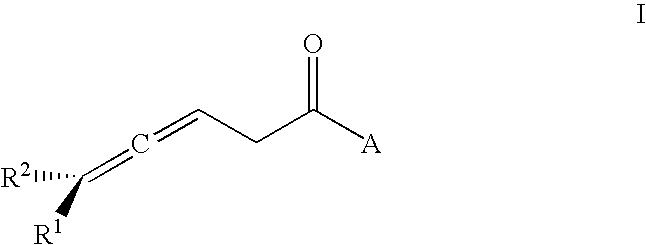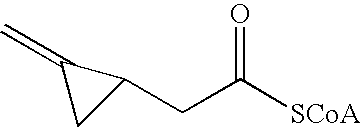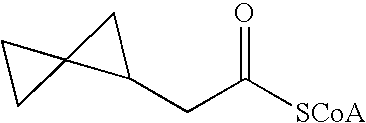Acyl-CoA dehydrogenase allenic inhibitors
- Summary
- Abstract
- Description
- Claims
- Application Information
AI Technical Summary
Benefits of technology
Problems solved by technology
Method used
Image
Examples
example 1
Synthesis of Racemic 3,4-dienoic Acids
[0112]Dienals are oxidized by silver oxide to provide the corresponding dienoic acids as previously described (H. R. Rodriguez, et al. in Tetrahedron 1968, 24, 6583–6589). The resulting acids are photo-isomerized with a Hanovia L 450-W high-pressure mercury lamp to provide racemic 3,4-dienoic acids as previously described (K. J. Crowley in J. Amer. Chem. Soc. 1963, 85, 1210).
example 2
Synthesis of Chiral 3,4-decadienoic Acids
[0113]Alternatively, methyl esters can be synthesized from racemic precursors by the orthoester Claisen rearrangement as described by T. Ebata et al., in Tetrahedron 1981, 37, 1343–1347. R(−)- and S(+)-1-octyn-3-ols are the precursors for R(−)- and S(+)- methyl decadienoates respectively (39). Each octynol (1.0 g) was mixed with propionic acid (40 mg) and trimethylorthoacetate (7.6 g) and refluxed under nitrogen at 105° C. for 6 h. After completion of the reaction (TLC: using methanol:ethylacetate 1 / 1 v / v; detection by iodine vapor) excess trimethylorthoacetate is removed by distillation at 120° C. The residue (1.68 g) is stirred for 30 min with 2 mL of 0.5 M H2SO4 and extracted with three 5 mL aliquots of ether. The extract is dried over anhydrous magnesium sulfate and the ether removed under reduced pressure to provide 1.30 g of a pale yellow liquid. δHH(CDCl3): -O-methyl, 3.75 ppm (s, 3H); C-2, 3.02 ppm (m, 2H); C-3 and C-5, 5.20 ppm (br, ...
example 3
Preparation of 3,4-allenic Thioesters
[0114]The allenoyl CoA thioesters are synthesized by the mixed anhydride method as described previously (H. Sprecher et al. in J. Biol. Chem. 1977, 252, 6736–6744) with minor modifications. 36.3 μmol allenic acid, 36.3 μmol isobutylchloroformate and 33.0 μmol of dry triethylamine are mixed in 2.0 mL dry tetrahydrofuran and stirred for 10 min at room temperature. CoASH (24.2 μmol in 1.5 mL of 250 mM phosphate buffer, pH 8.2) is added and the mixture stirred under nitrogen for 20 min. The solution is acidified to pH 5 with glacial acetic acid and the mixture extracted with ether. The remaining aqueous layer is purified by HPLC. A shallow gradient of methanol and 25 mM potassium phosphate, pH 5.3, is used to resolve the 3,4-allene from a small amount of 2,4-dienoyl-CoA contaminant. A typical elution program for 3,4-decadienoyl-CoA is: 1.5 min, phosphate buffer alone; 1.5–3.5 min, linear gradient to 65% methanol; 3.5–12 min, linear gradient to 66% me...
PUM
 Login to View More
Login to View More Abstract
Description
Claims
Application Information
 Login to View More
Login to View More - R&D Engineer
- R&D Manager
- IP Professional
- Industry Leading Data Capabilities
- Powerful AI technology
- Patent DNA Extraction
Browse by: Latest US Patents, China's latest patents, Technical Efficacy Thesaurus, Application Domain, Technology Topic, Popular Technical Reports.
© 2024 PatSnap. All rights reserved.Legal|Privacy policy|Modern Slavery Act Transparency Statement|Sitemap|About US| Contact US: help@patsnap.com










